Everything About Wireline Engineering

Moving tools and equipment up and down a well is an important and necessary task for drilling wellbores. To move tools safely and effectively in an oil or gas well operators use wireline. It is a cabling system which is helpful in bringing well tools up and down the wellbore. It is used for both well logging as well as for workover operations, and is a core component of wireline engineering in oil and gas wells.
The wireline system can be a single cable wireline or it can be multi-strand wireline. Also it is of two types which are electric or non-electric.
A wireline with a braided metal outer layer is known as a braided wireline. It is made up of an insulated conductor core surrounded by armored strands. A wireline provides electric pathways between tools attached to its end and the surface of the well, serving as a vital link in wireline engineering tasks like logging and intervention.
On the other hand, slickline is a non-electric single strand wireline. It is used to lower tools such as valves, gauges and plugs into the wellbore. Lowering and retrieving operations can be performed by reeling in and out the single cable using a hydraulic system.
Below are some wireline tools which provide various mechanical services:
Gauge Rings
These are open mouthed tools which are attached at the end of the electric wireline service. A gauge ring is made up of steel or any other metal and has proper inner and outer diameter. It is used to check the dimensional capability of different tools to perform specific functions accurately. Digital drift or caliper tools are also used in advanced operations.
Bridge Plugs
These are the drillable plugs which are placed down the well bore with the help of wireline. It is used for pumping pressure operations, multi zone isolation of a well, and multi zone stimulation of a wellbore. It doesn’t cause any damage to casing of the well and is easy to use.
Dump Bailer
This is a wireline tool used to apply or place cement slurry or other similar material inside the wellbore. This is the best tool to use to fill cracks in the well wall. It is available in many sizes; select the one according to the shape and dimension of the wellbore. When you attach a dump bailer with wireline ensure all its connections are tight to prevent leakage. Chemical or resin-based bailers are also commonly used for similar purposes.
Sand Line Cutter
If the tool gets stuck inside the wellbore then with the help of the cutter tool it can be released by cutting the length of wireline. Attach the cutter to the end of wireline and then drop it down on the top of the cable with the stuck tool. The tool cuts by rotating around its axis. This tool only cuts the cable without causing any damage to casing or any other equipment in the well. It is typically used with slickline and may require fishing equipment for retrieval, rather than being automatically retrievable, as not all versions retrieve themselves.
Blanking Plugs
This is used to pressurize the chamber beneath it. It allows fluid to pass through it when running in the well. The plug cannot be pulled up as long as the pressures above and below it are different. Thus, it also equalizes the pressure in the wellbore. Use the correct equalizing prong when removing wireline mechanical plugs and wait until the plug is completely equalized before you start to retrieve it. These plugs are important for temporary isolation and require careful pressure control.
Things to Consider While Using Wireline Tools
- Check and maintain all the wireline tools regularly.
- Check the connections of the tool with the wireline before each operation.
- Select the appropriate size of tool to attach with wireline as needed.
Wireline services and mechanical tools can be invaluable when drilling and maintaining wellbores, making wireline engineering essential for safe and effective operations. Newer technologies like digital slickline and fiber optic wireline are also becoming more common for improved real-time monitoring and precision.
Conclusion
Wireline engineering plays a critical role in ensuring efficient, accurate, and safe wellbore operations. By using the right tools and techniques, operators can optimize performance and minimize risk throughout the lifecycle of a well.
Would you like to receive similar articles by email?





